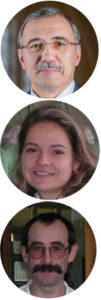Exploring intracellular calcium homeostasis with ratiometric measurements
Meet the Experts

László Csernoch, Group leader, Department of Physiology, University of Debrecen
Beatrix Dienes, Research Associate, Department of Physiology, University of Debrecen
Peter Szentesi, Research Associate, Department of Physiology, University of Debrecen
Email: [email protected]
Tel: +36 52 255 575
At the University of Debrecen (Hungary), experts in intracellular calcium homeostasis, Professor László Csernoch, Dr Peter Szentesi and Dr Beatrix Dienes, explain their research and the importance of ratiometric calcium measurements.
They recently started using the CoolLED pE-340fura Illumination System with their Zeiss Axio Vert microscope, and discuss their reasons for switching to this LED Illumination System.
Can you tell us about your research?
László: We are interested in intracellular calcium homeostasis. While this seems like a fairly simple statement, it impacts many different ideas and fields: from cancer research to ageing, and from disabilities to healthy people in unique environments like outer space. Our research started with studying excitation-contraction coupling in skeletal muscle, and alterations associated with mostly genetic disorders. We seek to understand the basic physiological functions of the molecules involved, calcium channels in the surface membrane and intracellular compartments, and the regulation of contractile proteins and the calcium binding to these proteins. This focus extended to smooth muscle within the vascular environment (i.e. smooth muscle cells which form blood vessel walls), where we are interested in the role of calcium in the calcification of these cells, known as arteriosclerosis. We also study non-excitable cells such as skin, including melanocytes after their malignant transformation to melanoma.
These are the major ideas of our research group, which could help those with genetic disorders resulting in muscle weakness, as well as muscle deterioration during natural ageing. These ideas are also important in space physiology, where skeletal muscle and bone is reduced in mass and function during spaceflight. By understanding these processes, we could improve muscle performance of astronauts during long spaceflights. For me, the phrase ‘to go where no man has ever gone before’ sums up my fascination with research: to study something that no one has ever looked at before. While we have a clear picture of what we would like to achieve in the future and how we could help society once we have proved our ideas, we have a weak picture of how we can do this, because it depends on securing the appropriate funding.
What role does ratiometric calcium measurements play in your research?
László: I first used ratiometric calcium measurements in 1990, not long after the publication of FURA-2. In 1994, Peter and I then hand-built a ratiometric system on a microscope, here in Debrecen. We later moved to a device for measuring single cells (Photon Technology International Delta Scan) which still works today. When our research moved towards the detection of low calcium release events referred to as calcium sparks, which I was also one of the first to study, it became necessary to analyse these events on a larger scale. We required a device to detect ratiometric calcium concentration changes in many cells simultaneously, and the wider field of view was what attracted us to the CoolLED pE-340fura Illumination System.
Beatrix: I visited a calcium conference in Germany a few years ago where I first heard of the CoolLED Illumination System. Since our existing setup was getting older and we are never sure when it will finish its contribution to our work, I was interested in the new system which was cheaper and just as good.
László: We use the CoolLED Illumination System for time-resolved ratiometric measurements. Under ratiometric conditions, movement of the cells does not interfere with the data, whereas with non-ratiometric dyes you can never be certain as to the cause of the changes. Ratiometric detection is based on the illuminating two wavelengths sequentially, which is either achieved by arc lamps due to the low wavelengths (340 and 380 nm), or you need an alternative light source. LEDs are now the alternative light source, being both cheaper and easier to use, whereas UV lasers are extremely expensive and not suitable for widefield detection.
Peter: The CoolLED Illumination System is coupled to a Zeiss Axio Vert motorised microscope, using AxioVision software and a high-speed camera to measure single XY images or a series. We use the software to calculate the background, and the ratio of the two images acquired from excitation of FURA-2 with 340 nm and 380 nm provides us with the calcium concentration value. The system is very useful and easy to use, which makes it much more accessible for everyone who is interested in ratiometric calcium measurements.
What studies do you use the pE-340fura for?
Beatrix: An ongoing project is looking at calcium channels in smooth muscle and their contribution to calcification. It seems that these channels could present a potential target for protection against calcification. If it turns out that we are correct, this will be a novel way of attacking arteriosclerosis, which is a serious problem for the elderly.
László: We are also looking into a protein we think influences cell migration. None of our findings using the CoolLED Illumination System are published yet, and we are working towards publications for next year.
How have you found the support from CoolLED and Zeiss?
Beatrix: The support is perfect. This also relates to Zeiss who helped us a lot with our setup.
László: We have a long connection with Zeiss and have been working with Antal [Antal Igaz, Sales Director at Zeiss] for nearly two decades.
Peter: We also did not expect Jo [Field Sales Manager at CoolLED] to come all the way to Hungary just to see how we are getting on.
For more information on this research, visit: www.researchgate.net/profile/Laszlo_Csernoch
Find out more about the CoolLED pE-340fura FURA-2 ratiometric calcium imaging light source
